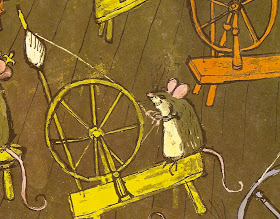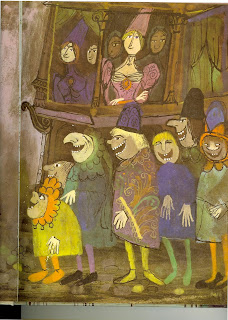As part of my plans for greatness, I had bragged without shame about my skills in every wine shop in the city. I had wanted everyone to know that I was the finest thief since mortal men were made…
But the thing about Gen is that there’s always a lot more going on than either the first-time reader or any of the other characters suppose. He is truly an unreliable narrator – an infuriating, intelligent, highly-strung, secretive, multi-layered individual whom you get to like very much indeed. And the book, with its sequels, is set in an almost but-not-quite familiar early Mediterranean world, where gods are worshipped who resemble the Greek pantheon but are not – and where small city states war against one another, or form alliances, under the shadow of a powerful Eastern empire.
Megan says she began her writing career in San Diego -
... so it's a special place for me. My husband was awarded a fellowship by the John SimonGuggenheim Foundation and we moved to San Diego for a year so that he could write a book. While he was working onhis book, I wrote my collection of short stories, 'Instead of Three Wishes'. We moved home to Maryland for a year andthen came back to San Diego the next summer. We stayed in the same apartment building,right across from the beach, and I drafted 'The Thief'. At the end of the summer we moved to Northern California for a year, and thenback to Maryland. We didn't come back to San Diego except for short visits for almost seventeen years, but last year,my husband had a year of sabbatical time accumulated and we knew where we wanted to spend it. As we drove across thecountry I was contemplating the edits from my editor on 'A Conspiracy of Kings'. When we arrived in San Diego again, I sat downand finished the book and sent it off. It came out in April, time for us to have a book launching party before wegot back in the car and drove home.
If you haven’t read ‘The Thief’, I’m certainly not going to spoil the surprises for you, but the writing is a joy, the characterisation is wonderful, and story is breathtaking. Because of his boast “I can steal anything”, Gen is employed as a tool by the King’s Magus, to penetrate the site where an ancient treasure, Hamiathes Gift, is said to lie. But the dangers are great. Here’s the moment when Gen sees the place for the first time – hidden behind a waterfall:
…in the space of a few heartbeats, the river disappeared. The flow of its water stopped, came again in slushy bursts over the falls, and then stopped again.
... In the bulging rock where the waterfall had been, there was a recessed doorway. The lintel of the doorway was the rock itself, but set into it were two granite pillars. Between the pillars was a door pierced by narrow slits that were wider in their middles and narrower at the ends. The river water still sprayed through these slits and dropped into the round pool that remained in the basin below.
“I wanted to get here at least a day early, to give you a chance to rest,” said the magus. “The water will begin to flow again just before dawn. You have to be out again before that, as I assume the temple will fill quickly.”
The Thief was followed by its sequels, ‘The Queen of Attolia’, ‘The King of Attolia’, and ‘A Conspiracy of Kings’ and from an impressive start the books just get better and better. One of the many things I admire about them is their sheer intelligence. Lots of devious politics. Lots of twists. Characters do bad things – even cruel things – and yet we find ourselves in a process of learning more and more until we are forced to question our earlier judgements and see the characters differently. Interesting also is the way Megan Whalen Turner moves us away from her hero Eugenides book by book, even while he is still the focus of each. In ‘The Thief’, he is the first person narrator. ‘The Queen of Attolia’ is told in the third person: although Eugenides is still the main character, we see him often through the eyes of others – his close friends, family and enemies. In ‘The King of Attolia’, the point of view is that of the hopelessly straightforward young soldier Costas, completely and comically out of his depth as Eugenides’ unwilling bodyguard. And in ‘A Conspiracy of Kings’, we are back to the intimacy of first person narration – but by an entirely different character. I understand there’s another sequel on the way, and I cannot wait to read it.
Oh, and in case I didn’t make it clear, these books aren’t just cerebral. Megan's writing also encompasses tenderness and beauty and the sheer numinous otherness of the gods. And here she is to talk about a book of fairytales she had as a child:
When Katherine asked if I might like to write a blog post about my favorite fairy tale, I drew a blank. Having read the previous posts and their loving attention to various stories, I’m almost afraid to admit this, but I didn’t like fairy tales when I was a kid. I thought they were dry, their characters two dimensional and their plots predicatable. But as I wrote my e-mail, meaning to decline, one particular book did come to mind. It was Alice and Martin Provensen’s book of fairy tales, and I remembered it mainly for the illustrations, which were terrifying.
I asked Katherine if that sort of subject would do for a non-fairy tale reader and she said, yes. So . . .
THE PROVENSEN BOOK OF FAIRYTALES
This book sat on my shelf untouched for years. Too disturbing to read, too compelling to overlook, it was a gift and absolutely could not be sent off to the library book sale. No matter how many times I weeded my collection, it always remained. There on the shelf, with its dark mesmerizing illustrations in black and purple and virulent green.
Those of you familiar with the deeply charming Animals of Maple Hill Farm, or with A Visit to William Blake's Inn which won both the Newbery Award and a Caldecott Honor in 1982 might be surprised that anything by the Provensens could be that disturbing.
Yes, well they were always about more than cats and bunnies and talking sunflowers. In The Animals of Maple Hill Farm the Provensens introduce you to all the hens and roosters at their farm in a two page spread that includes examples of the obnoxious rooster, Big Shot, being nasty to the other roosters and bullying the hens, and then Big Shot gets carried off by a fox.
Look through A Visit to William Blake’s Inn and notice the semi-circular smile on the Man in the Marmalade Hat. That's him on the left.
Observe his chiclet style teeth. Imagine an entire book peopled with those smiles and those teeth, and no friendly anthropomorphic sunflowers, either. The best you get is some malevolent looking mice.
A mouse from "The Forest Bride" by Parker Filmore.
This from the story “The Lost Half Hour” by Henry Beston:
Or this from “Beauty and the Beast” by Arthur Rackham:
I couldn’t fit this into one scan, but if you look carefully you can piece together the composition with Beauty sitting at the table and the Beast lurking just around the corner. The Provensens have used the gutter between the pages to emphasize the corner in the image. The images aren’t merely frightening, they are brilliant and frightening. The hands of the beast are huge and clawed, yet they hang awkwardly, giving you the idea that in an unfortunate fumbling manner they might accidentally rip your arm off.
This is from the happy, upbeat (not), The Prince and the Goose Girl by Elinor Mordaunt.
Holy Cow. This book gave me the heebie-jeebies.
So, of course, I left it on the shelf when I grew up and moved out on my own. And I never read it when I visited home. No, never. And when I saw a copy at a thrift store, of course I said, “Oh, look!” And bought it instantly.
Okay, so there . . . there may be a contradiction there. And when I said the book sat on my shelf untouched? I lied. When I got the book home and looked through it, I remembered every single story. "The Lost Half Hour" where poor unfortunate Bobo is sent out by the Princess to find the half hour lost while she overslept. “Feather O’ My Wing” by Seamus McManus with the same spiteful stepsisters as “Beauty and the Beast,” but a story line a little more like “East of the Sun, West of the Moon.” Barbara Leonie Picard’s "Three Wishes" were the peasant boy gives away his hard earned wishes and receives them all back again.
And perhaps my favorite, “The Prince and the Goose Girl.” The heroine Erith is absolutely indomitable. She won’t back down, not even if it costs her life, and when the Prince realizes this he also realized that Erith is right that he isn’t much of Prince. Fortunately, he becomes a reformed man, and because Erith is as kind as she is brave, it all works out in the end.
Why, oh, why didn’t I think of "The Prince and the Goose Girl" when Katherine asked me to write a post?
I think the answer has something to do with the Introduction to the book, which may be the one part I really didn’t read. In the introduction Joan Bodger explains that these are literary fairy tales. The italics are hers, not mine and their elitism makes me uncomfortable, but I think Bodger is saying the same thing that I am struggling with. I didn’t like fairy tales when I was growing up because most of the things that were labeled “Fairy Tales” in my experience were those bowdlerized, dessicated versions that were three paragraphs long and came in books of a hundred or more and had absolutely no personality. Everything that gave them depth had been sifted out because it was rude, or it was frightening, or it made the story too long for its intended audience.
They were stripped down to their Propp’s morphology. I tend to think of them as skeletons of stories, but the Provensons remind me that they aren’t dead skeletons so much as a seed bank that any of us can draw on, and that when we do draw on this seed bank, what we are writing (with or without the upscale qualifier literary) is fairy tales.

















